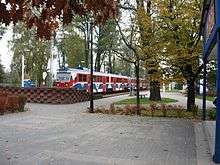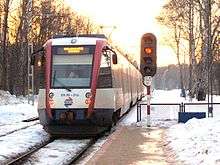Warsaw Commuter Railway

Warsaw Commuter Railway (Polish: Warszawska Kolej Dojazdowa, WKD) is a commuter rail line in Poland's capital city of Warsaw. The line, together with its two branches, links Warsaw with the municipalities of Michałowice, Pruszków, Brwinów, Podkowa Leśna, Milanówek and Grodzisk Mazowiecki to the south-west of Warsaw.
History
.jpg)



The line was constructed and operated under the original name Elektryczne Koleje Dojazdowe (Electric Commuter Rail) by a privately owned electrical power industry consortium Siła i Światło (Power and Light) established with the participation of British capital shortly after Poland regained independence after World War I in 1918. The consortium sought to build an electric railway in order to accelerate economic development and increase the demand for its services. To achieve this goal it created in 1922 the company Elektryczne Koleje Dojazdowe S.A., owned in 40% by Siła i Światło, 25% by one of the financing banks and the remaining 35% held by small shareholders.
In 1924 the company received a concession from the ministry of transport to build a private railroad from Warsaw through Grodzisk Mazowiecki to Żyrardów, under the condition that it would be run at least 2 kilometers from the existing line of the former Warsaw-Vienna Railway owned by the Polish State Railways (PKP). The work began in Komorów and proceeded simultaneously in two directions. In 1927 a 32.4 kilometers long standard gauge line electrified at 650 V DC with overhead wire was opened, linking Grodzisk Mazowiecki with the center of Warsaw. The line was connected with a 3 kilometer long non-electrified technical line with national rail system in Komorów, 24 kilometers of the line between Podkowa Leśna and Warsaw consisted of double track, the four kilometers long segment of the line leading to railroads final station in Warsaw at Marszałkowska Street was embedded in the city streets. The railroad operated 20 four-axle electric railcars produced by the English Electric Company at Preston, capable of traveling with a speed of up to 70 km/h, along with 20 unpowered passenger cars.
In 1932 the line was extended in Grodzisk Mazowiecki to reach Grodzisk Mazowiecki PKP station and a short branch line was built in Włochy just outside Warsaw, likewise linking with the Włochy PKP station. In 1936 a branch line was opened from Podkowa Leśna to Milanówek with PKP station there. Before the outbreak of World War II work was initiated on the construction of second line from Komorów to Nadarzyn and Mszczonów.
The Elektryczna Kolej Dojazowa in 1939 carried 4000 passengers a day and ran trains every 10 minutes during rush hours. Its core business had not yet reached profitability, however the company made money reselling real estate which gained in value significantly due to the railroad.
During World War II the railroad remained operational during most of the German occupation albeit only on part of the line. In 1947 the company was nationalized by the Soviet installed communist government and in 1951 placed under the administration of the Polish State Railways and renamed to Warszawska Kolej Dojazdowa (Warsaw Commuter Rail), however the line retained a narrower loading gauge and its specific electrification system while the national rail network uses 3 kV DC. During the 1960s the line was gradually trimmed at its and ends and in Warsaw moved to newly built tracks in the cutting of western part of the Warsaw Cross-City Line. In 1972 the almost half-a-century-old English Electric railcars were replaced by new PKP class EN94 EMUs produced by Pafawag in Wrocław designed specially for the line.
In 2001 with the restructuring of the Polish State Railways a separate company called PKP Warszawska Kolej Dojazdowa Sp. z o.o. was created within the PKP Group and in 2007 taken over by a consortium formed by the Masovian Voivodeship and the municipalities through which the line runs, dropping the letters PKP from its name.
Several proposal have been made for the modernization of line, proposing alternately either switching the line to standard tram rolling stock and eventually integrating with the Warsaw Tramway system or rebuilding the line to standard rail loading gauge and converting to 3 kV electrification system in order to integrate it with the national rail network. Additionally plans have been prepared for moving the final station of the line in Warsaw to Rondo Dmowskiego at Marszałkowska Street in order to facilitate easier transfers to the Centrum station on the city's first metro line and to build the line between Komorów and Nadarzyn, however as of 2011 no funds have been allocated towards any of those.
In 2004 Warszawska Kolej Dojazdowa received a single prototype of a new EMU designated PKP class EN95 built by PESA in Bydgoszcz which remains in service today, however no further units of this type have been ordered. Instead in 2010 the company ordered also from PESA 14 EMUs class EN97 (a.k.a. 33WE) of a completely new design, requiring in the specification the possibility to convert them to the voltage used on the national rail network.
Route
Warszawska Kolej Dojazdowa | |||||||||||||||||||||||||||||||||||||||||||||||||||||||||||||||||||||||||||||||||||||||||||||||||||||||||||||||||||||||||||||||||||||||||||||||||||||||||||||||||||||||||||||||||||||||||||||||||||||||||||||||||||||||||||||||||||||||||||||||||||||||||||||||||||||||||||||||||||||||||||||||||||||||||||||
|---|---|---|---|---|---|---|---|---|---|---|---|---|---|---|---|---|---|---|---|---|---|---|---|---|---|---|---|---|---|---|---|---|---|---|---|---|---|---|---|---|---|---|---|---|---|---|---|---|---|---|---|---|---|---|---|---|---|---|---|---|---|---|---|---|---|---|---|---|---|---|---|---|---|---|---|---|---|---|---|---|---|---|---|---|---|---|---|---|---|---|---|---|---|---|---|---|---|---|---|---|---|---|---|---|---|---|---|---|---|---|---|---|---|---|---|---|---|---|---|---|---|---|---|---|---|---|---|---|---|---|---|---|---|---|---|---|---|---|---|---|---|---|---|---|---|---|---|---|---|---|---|---|---|---|---|---|---|---|---|---|---|---|---|---|---|---|---|---|---|---|---|---|---|---|---|---|---|---|---|---|---|---|---|---|---|---|---|---|---|---|---|---|---|---|---|---|---|---|---|---|---|---|---|---|---|---|---|---|---|---|---|---|---|---|---|---|---|---|---|---|---|---|---|---|---|---|---|---|---|---|---|---|---|---|---|---|---|---|---|---|---|---|---|---|---|---|---|---|---|---|---|---|---|---|---|---|---|---|---|---|---|---|---|---|---|---|---|---|---|---|---|---|---|---|---|---|---|---|---|---|---|---|---|---|---|---|---|---|---|---|---|---|---|---|---|---|---|---|---|---|---|
| |||||||||||||||||||||||||||||||||||||||||||||||||||||||||||||||||||||||||||||||||||||||||||||||||||||||||||||||||||||||||||||||||||||||||||||||||||||||||||||||||||||||||||||||||||||||||||||||||||||||||||||||||||||||||||||||||||||||||||||||||||||||||||||||||||||||||||||||||||||||||||||||||||||||||||||
Starting as double-track from the Warszawa Śródmieście WKD terminus adjacent to the mainline Warszawa Centralna railway station, the line initially runs to the west alongside Warsaw's main east-west railway line before turning to the south-west on its own right of way. The length of the Warszawa Śródmieście WKD to Grodzisk Mazowiecki Radońska line is 33 km, and of the Milanówek branch 3 km. The stations are:[1]
- Warszawa Śródmieście WKD
- Warszawa Ochota
- Warszawa Zachodnia
- Warszawa Reduta Ordona
- Warszawa Aleje Jerozolimskie
- Warszawa Raków
- Warszawa Salomea
- Opacz
- Michałowice
- Reguły
- Malichy
- Tworki
- Pruszków WKD
- Komorów
- Nowa Wieś Warszawska
- Kanie Helenowskie
- Otrębusy
- Podkowa Leśna Wschodnia
- Podkowa Leśnia Główna
- Podkowa Leśna Zachodnia
Here the line splits into two single-track branches. The stations on the Milanówek branch (line 48) are:
- Polesie
- Milanówek Grudów
The stations on the Grodzisk Mazowiecki branch (line 47) are:
- Kazimierówka
- Brzózki
- Grodzisk Mazowiecki Okrężna
- Grodzisk Mazowiecki Piaskowa
- Grodzisk Mazowiecki Jordanowice
- Grodzisk Mazowiecki Radońska
There is a single-track non-electrified link between the Komorów station and the PKP rail network (Pruszków station), carrying no scheduled traffic.
Operation
The company's headquarters and the main technical depot are in Grodzisk Mazowiecki. The WKD is a standard gauge line and is electrified at 600 V DC[2] on the overhead system. Train services is provided by three classes of train sets:
- EN94 two-car articulated electric units, 40 units built between 1969 and 1972 in Wrocław and normally operated in pairs.
- EN95 four-car low-floor articulated electric unit, one unit built in 2004 in Bydgoszcz.
- EN97 four-car low-floor articulated electric units, 14 units built in 2011–2012 in Bydgoszcz.
There are plans to order further six units.[3]
In 2013 the line will be re-electrified at 3 kV DC.[3] The remaining EN94-class units will then be scrapped and the single EN95-class unit will be rebuilt for that supply. EN97 will require a simple conversion.
The company also owns a vintage type EN80 four-axle electric unit, built by English Electric at Preston in 1927, and a small diesel shunter, obtained second hand from PKP.[4][5]
On the main line, trains operate every 15 minutes at peak hours and every 30 minutes off-peak, with a service gap between midnight and 05:00. For most of the day, one train an hour runs through to Milanówek Grudów, with most of the other trains running through to Grodzisk Mazowiecki Radońska. All trains stop at all stations on their route, and a journey from Warszawa Śródmieście to Grodzisk Mazowiecki Radońska takes just under one hour.[6]
Within Warsaw's borders, WKD accepts day tickets and transit passes issued by the Warsaw Transit Authority.[7]
References
- ↑ "WKD - Route Map". Warszawska Kolej Dojazdowa. Retrieved September 18, 2006.
- ↑ The only public railway line in Poland, all other electrified lines use 3 kV DC overhead system.
- 1 2 "About the company—Future plans" (in Polish). WKD. Retrieved 4 January 2013.
- ↑ "Rail Operators in Poland". railfaneurope.net. Retrieved September 19, 2006.
- ↑ "WKD shunters and trainsets". railfaneurope.net. Retrieved September 19, 2006.
- ↑ "Rozkład jazdy kolejki WKD Warszawa - Grodzisk Mazowiecki". Warszawska Kolej Dojazdowa. Retrieved September 19, 2006.
- ↑ "ZTM Warszawa - tickets and charges". Zarzad Tranportu Miejskiego. Retrieved January 10, 2010.
External links
-
 Media related to Warsaw Commuter Railway at Wikimedia Commons
Media related to Warsaw Commuter Railway at Wikimedia Commons - Official website